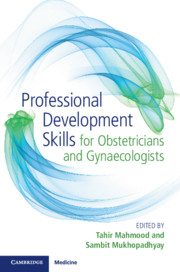Book contents
- Professional Development Skills for Obstetricians and Gynaecologists
- Professional Development Skills for Obstetricians and Gynaecologists
- Copyright page
- Contents
- Figures
- Tables
- Contributors
- Preface
- Chapter 1 Teaching and Facilitating Learning in Obstetrics and Gynaecology
- Chapter 2 Supporting Professional Development: Assessment and Appraisal in Obstetrics and Gynaecology
- Chapter 3 Research Methodology and Research Governance in Obstetrics and Gynaecology
- Chapter 4 Information Technology in Daily Practice in Obstetrics and Gynaecology
- Chapter 5 Clinical Governance in Obstetrics and Gynaecology
- Chapter 6 Clinical Standards in Obstetrics and Gynaecology
- Chapter 7 Revalidation in Obstetrics and Gynaecology
- Chapter 8 The Doctor as an Educator
- Chapter 9 Clinical Audit in Obstetrics and Gynaecology
- Chapter 10 Clinical Risk Management in Obstetrics and Gynaecology
- Chapter 11 Ethics and Legal Issues in Obstetrics and Gynaecology
- Chapter 12 Clinical Leadership and Service Delivery in Obstetrics and Gynaecology
- Chapter 13 Human Factors in Maternity Care
- Index
- References
Chapter 8 - The Doctor as an Educator
Published online by Cambridge University Press: 13 October 2018
- Professional Development Skills for Obstetricians and Gynaecologists
- Professional Development Skills for Obstetricians and Gynaecologists
- Copyright page
- Contents
- Figures
- Tables
- Contributors
- Preface
- Chapter 1 Teaching and Facilitating Learning in Obstetrics and Gynaecology
- Chapter 2 Supporting Professional Development: Assessment and Appraisal in Obstetrics and Gynaecology
- Chapter 3 Research Methodology and Research Governance in Obstetrics and Gynaecology
- Chapter 4 Information Technology in Daily Practice in Obstetrics and Gynaecology
- Chapter 5 Clinical Governance in Obstetrics and Gynaecology
- Chapter 6 Clinical Standards in Obstetrics and Gynaecology
- Chapter 7 Revalidation in Obstetrics and Gynaecology
- Chapter 8 The Doctor as an Educator
- Chapter 9 Clinical Audit in Obstetrics and Gynaecology
- Chapter 10 Clinical Risk Management in Obstetrics and Gynaecology
- Chapter 11 Ethics and Legal Issues in Obstetrics and Gynaecology
- Chapter 12 Clinical Leadership and Service Delivery in Obstetrics and Gynaecology
- Chapter 13 Human Factors in Maternity Care
- Index
- References
- Type
- Chapter
- Information
- Publisher: Cambridge University PressPrint publication year: 2018



